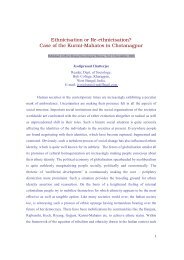Chapter 5 - WebRing
Chapter 5 - WebRing
Chapter 5 - WebRing
Create successful ePaper yourself
Turn your PDF publications into a flip-book with our unique Google optimized e-Paper software.
CHAPTER 5. MAGNETIC SYSTEMS 269<br />
(a) (b)<br />
Figure 5.17: (a) A typical microstate of the Ising model. (b) The same microstate in the lattice<br />
gas picture with spin up replaced by a particle and spin down replaced by an empty cell.<br />
(a) What is the relation of the q = 2 Potts model to the usual Ising model? In particular, what is<br />
the relation of the interaction energy K defined in the Potts model and the interaction energy<br />
J defined in the Ising model?<br />
(b) ProgramPottsModelimplements the Wang-Landau algorithm for the Potts model on a square<br />
lattice. Run the program for L = 16 and various values of q and verify that the peak in the<br />
heat capacity occurs near the known exact value for the transition temperature given by<br />
Tc = (ln(1+ √ q)) −1 . You will need more than 100,000 Monte Carlo steps to obtain reliable<br />
data.<br />
(c) Choose q = 2 and q = 3 and observe the energy distribution P(E) = Ωe −βE at T = Tc. Do<br />
you see one peak or two?<br />
(d) Choose q = 10 and observe the energy distribution P(E) at T = Tc. You should notice<br />
two peaks in this distribution. Discuss why the occurrence of two peaks is appropriate for a<br />
first-order transition.<br />
5.9 *Lattice Gas<br />
The Ising model is useful not only because it is the simplest model of magnetism, but also because<br />
it can be applied to many other systems. Two common applications are to fluids and to binary<br />
alloys. In the fluid model a spin of +1 represents a particle and a spin of −1 represents a void<br />
(see Figure 5.17). The hard core repulsion between particles at short distances is modeled by<br />
the restriction that there is at most one particle per site. The short-range attractive interaction<br />
between particles is modeled by the nearest-neighbor Ising interaction.<br />
Binary alloys are modeled in a similar way with +1 representing one type of atom and −1<br />
representing a second type. The Ising interaction models the tendency of like atoms to be near<br />
each other because the attraction between like atoms is stronger than that between unlike atoms<br />
in binary alloys. In this section we will focus on the fluid model, which is called the lattice gas.

















